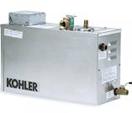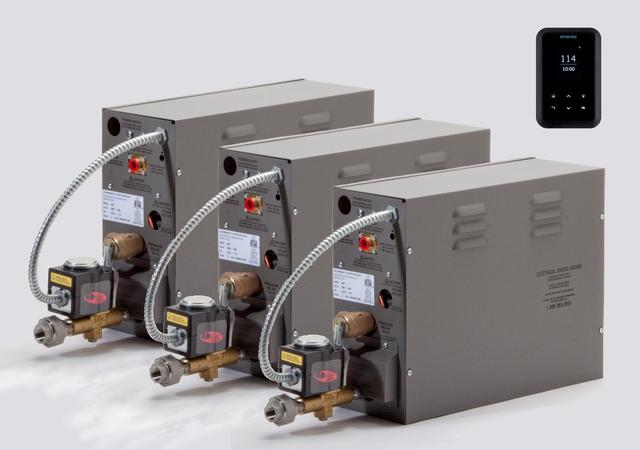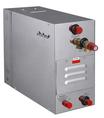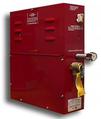Steam Fluence
Understanding what Steam Dryness is, is critical to being able to analyze the various steam generator brands as well as knowing what your preferences are for a steam therapy experience. This was one of the crucial pieces of information that I spent $12,000 to a Steam Consulting Firm to analyze the steam output of the top six brands of generators.
I have traveled around the country experiencing various steam spas at clubs, hotels, gyms, Spas, and also showrooms with the most common steam generator brands you might find in a Home Depot to some exclusive commercial high end steam generators that is not sold to the public. For anyone who has at least tried a couple different steam room setups, I am going to provide some examples of the most common experiences to help clarify what could be very technically scientific differences between generators. Most people don’t want to feel like they are going back to Science class which unfortunately is the level of self education it takes to figure out what to buy..but since I have already done this work I will try to keep things as simple as possible. Just know that there is science behind figuring this stuff out don’t be easily convinced with unsubstantiated claims and subjective information stated as Fact by all the sales people out there for these various steam generator companies.
For anyone that doesn’t have the time nor interest in reading this kind of info and just wants to be guided more directly please feel free to give me a call or send me an email.
1.The last steam room I visited was at a lower end gym while I was on a trip. First thing I noticed was steam on the mirrors in the bathroom. That was a bad sign as it is showing me that the steam room is not sealed around the door properly.
When I opened the door I noticed that the steam did not rush out past and around me. What this immediately told me was that the actual density of steam inside the steam room was not that much greater than the outside which told me that most likely the generator was not continuous or was designed for a smaller room space. A good sign of a generator that is producing enough volume of steam and at a dryer scale (less condensed water with higher latent heat) is that the steam rushes past the person who enters the room and even after the door closes it should still be challenging to see the person sitting a couple feet away on the bench ie. there should be enough density of steam to spare a few people opening the door without the generator having to kick on immediately (if it is a single tank).
Now these observations are not that accurate if the steam room has a generator that is continuous function (has two tanks) which is ideal as it builds up a lot of steam volume and density quickly as it never shuts off. One thing that has always surprised me is that even in high end gyms ($200-300 per month membership) it is not that common to sit in a steam room that has dual tanks running on a continuous mode! I more often experience these types of generators at Spas and higher end hotels.
In terms of the most popular generator brands on the market, only a few have dual tank options which I always highly recommend for multiple reasons which I discuss elsewhere on my site.
2.The other common experience in a steam room is walking into one and noticing that you can see the ceiling very visibly. Remember steam rises so the last thing you should be seeing is the ceiling versus your neighbor right next to you which is more likely. The lower end generators produce steam that is simply more saturated or ‘wetter’and heavier, has faster entropy, lower volume expansion efficiency and rate, and lower heat temperature (the latter can be measured with a simple device I use in my videos) that transfers to your physical body as well as the walls of the room. Low end generators have a higher produce a lower steam dryness fraction. This is the measurement of what percentage of the steam is gas versus water. A really good generator might produce something that is 3-5% water mix. Why is this good because normally steam contains 10% water by mass. The less water in the steam the closer to the less dense gas state and higher latent heat it has so it condenses more slowly so this has the effect of hanging in the air longer.
There is one test that easily shows how good the generator is with steam dryness fraction is using a humidity thermometer and tracking the change right after the steamer fills the room then shutting it off and seeing how long it takes for the steam to condense and the humidity to fall to 80%. (I show this in one of my videos). It’s fairly obvious what is going on when a high end steam room takes 30 minutes for the humidity index to fall to 80% versus a low end steam room where it takes 10 minutes.
Another test that can be done is how much steam condenses on the wall or glass door within 30 minutes. I turn the generator on for one cycle then collect how much water drips down a specific area of a wall or door (I make sure to keep the surface area measured the same in the various rooms I test) into a rubber tube that routes the water into a cup. This is not always the most accurate test but sometimes does provide some good info if the overall size of the room and materials used in its construction is similar (tile walls with same square footage room dimensions more or less).
3. Another common experience in steam rooms is walking in and finding it relatively easy to breathe and this is regardless of if the generator is spewing out steam or you are waiting for it. What to pay attention to is the steam rooms where it feels like each breath I take its super hot inside of my nose. In fact I force myself to just breathe for the first minute through my nose to assess the temperature of the steam. This is a very telling observation on the efficiency and quality of the steam generator. Steam that has a higher temperature (I analyze this in my vids) means it has more latent heat and the only way that is possible is if the dryness fraction is higher (less water droplets in the vapor).
The only way for a generator to create those dryer and hotter conditions is by higher pressure inside the tanks, properly outgassing excess air inside the tanks (this is a commonly overlooked specification), and heating the water hotter. Steam that is at or near water’s boiling point, 212 degrees F will contain higher percentage of liquid water versus than water heated hotter. Just for reference sake heating to 240 degrees creates dry steam which is 5-6% water.
Better generators will use a dual tank so that the water being held in the reserve can have a little bit more time to be heated to higher temperatures. Since the water is not in the tank for long subjecting it to higher PSI or pressure is a way to make water boil in less time (think pressure cookers for making meals in less time). Having more air in the tanks affect all this efficiency and the dryness fraction etc. so good generators release the air through valves. This air in cheaper units can leak into the tanks when not being used in between sessions.
All these features are more expensive in general so higher end generators will incorporate them. There are a couple exceptions of brands that do not really charge much extra for these important aspects.
Personal Steam Room Preferences are important:
So here I am talking about ways to tell the quality of the steam and generator but all of this can be useless depending on a person’s preferences of steam therapy experience.
This is why I created the questionnaire or ‘quiz’ on my site to assess these things. For example, better steam production might be 20 degrees hotter which makes it much more intense to breathe but ‘better’ doesn’t mean preferable. What if someone has sensitive sinuses or just the opposite they find the extra heat opens them up more effectively. Is the person wanting steam therapy for relieving sore muscles or pain? If so then having a hotter steam (dryer fraction) production is important.
I have found that for older folks who find most steam rooms hard to breathe in they prefer continuous dual tank generators that can be temperature adjusted. Having a steady supply of steam at a lower temperature is far easier than a single tank that shoots a (uncontrolled temperature) huge amount of hot steam to fill up the space all at once then shuts off. As that tank is fully emptying itself it can be a very unpleasant experience that is repeated over and over again!
Higher end generators will have temperature controls and they better brands will have the capability to produce steam at higher temperatures than the other brands. Even if a person doesn’t plan on using it on the higher temp setting knowing that the generator is capable of those higher temperatures actually reflects the technology and design inside the unit as being superior. Did you ever wonder why a unit that looks the same size can be $10, 000 and one $1,500?
Some people might be on a tight budget and can only afford a lower temp single tank type of unit. There are steam hacks in a way on the setup of the personal shower spa to help increase the efficiency and quality of the steam. For example, keeping the walls as hot as possible. What this does is super heat the steam or add more latent heat energy to the steam that nears the walls. One can do this by running Infrared Nano Carbon panels behind the walls or using just standard hot water piping behind them.
If the walls are hotter than the steam that is created after a tank empties itself is suspended in the air for longer and condenses more slowly as the vapor is receiving extra latent heat energy from the walls. Infrared actually moves out in a beam into the water vapor directly and can act on them in the air as Infrared is a light wave. This is helpful if a person purchases a single tank unit.
The other steam room hack is actually opening up the generator itself and putting extra piping insulation which can be picked up from any plumbing supply store. Many of the cheaper units I was shocked to find (some more expensive units as well) had no piping insulation! What this means is that the steam is already condensing and losing latent heat potential as it travels before it even leaves the valve into the room.
Which steam generator best serves You? I compile useful information to help you make a decision.
Steam Spa - Steamist - MR. STEAM - KOHLER - Amerec - STEAMBATH - THERMASOL -Whirlpool - ROMA - STEAMCORE
Take the
Dry Steam VS WET Steam Generators
The Most important page on this site
How to choose between the 2 Types
Don't buy without reading this page.
The higher the fluence the brighter the laser beam. This is what it looks like in a commercial steam room at 113 degrees at 100% humidity.
Need advice, call Sharon or Alex at 1-877-310-8385
1-877-310-8385
Open from 8am till 10pm
Ask for Alex
SteamReviewed.com
1-877-310-8385
Open from 8am till 10pm
Ask for Sharon
Some generators put out 2 gallons of steam in a 30 minute session while others put out 1.5 gallons.
There are slow burn and fast burn types which helps us determine the fluency of the steam.
A steam that comes out at 100 grams per minute has a different fluence than 100 grams coming out of the steam head over minutes.













